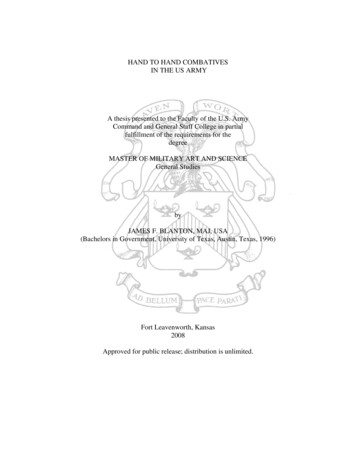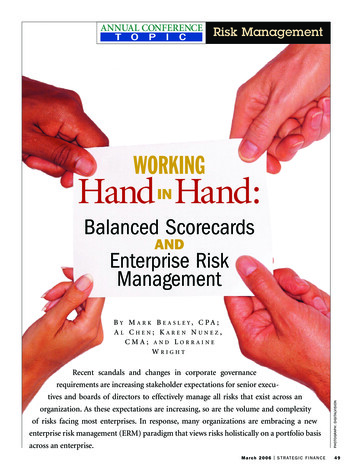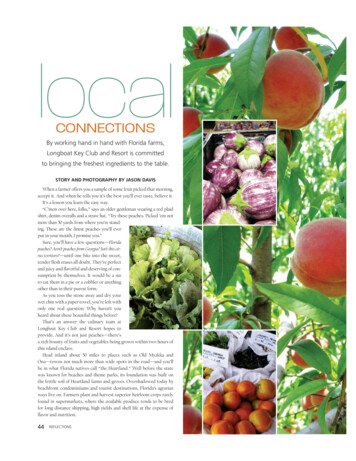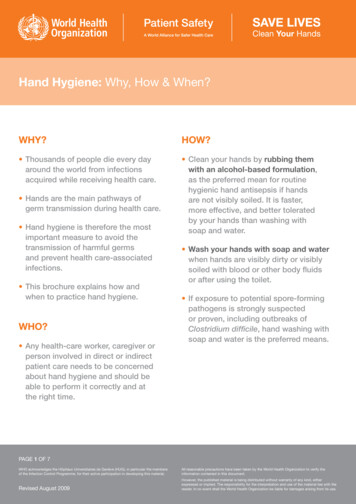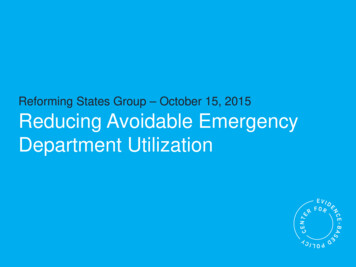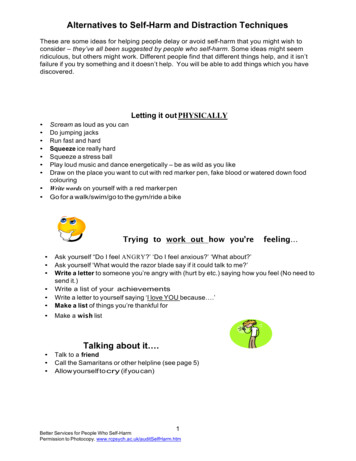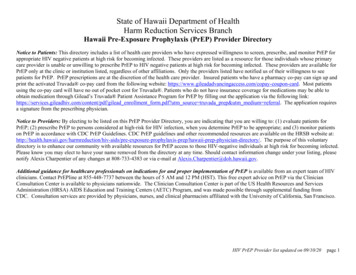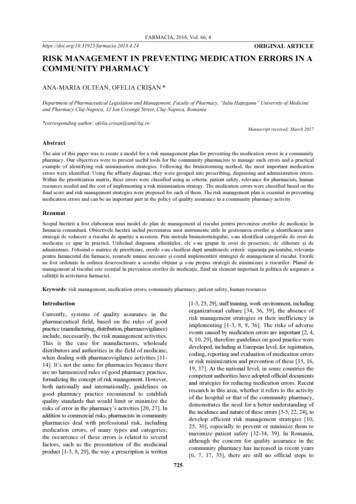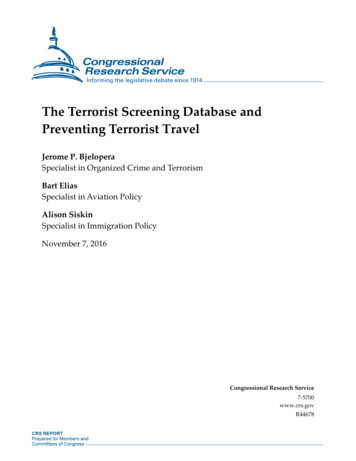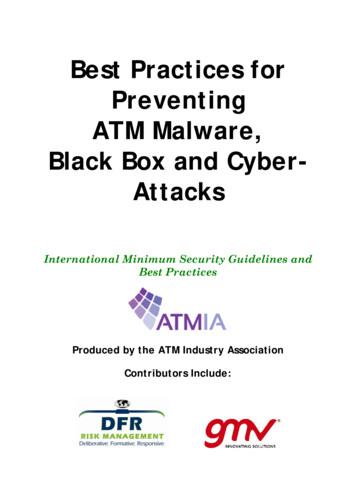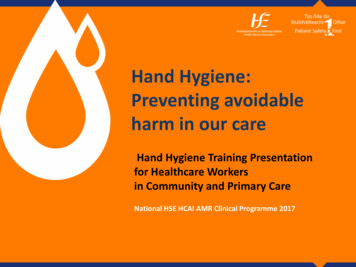
Transcription
Hand Hygiene:Preventing avoidableharm in our careHand Hygiene Training Presentationfor Healthcare Workersin Community and Primary CareNational HSE HCAI AMR Clinical Programme 2017
What we will cover Why you should clean your hands What are Healthcare associated Infections The ‘5 Moments of Hand Hygiene’ The golden rules of hand hygiene Hand hygiene and glove use Hand Hygiene Technique
Learning outcomes Consider the current experiences for usinghand hygiene in your workplace Understand why, how and where hand hygieneis important How to make improvements to achieve handhygiene compliance that is safe
The impact of HCAI on our patientsHCAI can cause: more serious illness prolonged stay in a health-carefacility long-term disability excess deaths high additional financial burden tohealth services high personal costs on patients andtheir families
What are Healthcare Associated Infections An infection that is acquired after contact withhealthcare services. Examples include Clostridiumdifficile (C diff.) and methicillen resistantStaphylococcus aureus (MRSA) A bacteria commonly referred to as C diff which canbe acquired after antibiotic use Spread from person to person or picked up in theenvironment/equipment or healthcare workers handsthat is contaminated with C diff. (MRSA) can be transmitted from person to person oragain from the healthcare workers hands,environment or equipment5
InfectiousDiseaseAny germs that can causedisease including bacteriaviruses, parasites and fungusSusceptible HostPersons at risk for getting aninfection including elderly, youngbabies, people with chronic diseasesuch as diabetes, asthma . Having awound or devices such as cannulasand catheters or feeding tubes inthe bodyReservoirTHE CHAINOFINFECTIONPortal of EntryWhere germs enter the bodyincluding open woundscatheters, feeding tubescannulas,or mucousmembranesPlaces where the germs can live andspread include food,water, toiletseat, door handles, human faecesand other body secretionsPortal of ExitMode of TransmissionHow the germs spread eitherby direct contact such asperson to person by hands orindirect contact including theenvironment or equipmentused to provide careWhere the germs leave thereservoir: includes thenose,mouth, back passage,urinary tract or blood and bodyfluids6
For an infection to develop, each link ofthe chain must be connected.Remember breaking ANY link of thechain can stop the transmission ofinfection!7
Example of a HCAI which is preventableCatheter associated urinary tract infections (CAUTI).By reducing the number of people that access ormanipulate devices including catheters, cannulas andfeeding tubesBy ensuring that those that do make contact withdevices, do it consistently correctGood hand hygiene practices will help reduce the riskof catheter associated urinary tract infection for theperson that has the urinary catheter in place8
What is Hand Hygiene?Hand Hygiene includes cleaning handswith alcohol-based hand rub (ABHR) orsoap and water in order to removegerms, also known as microorganisms9
So why and when should weclean our hands during our work?10
Why we clean our hands Protect patients and clientsagainst harmful germscarried on your hands orpresent on his/her skin Protect yourself and theenvironment from harmfulgerms11
1Germs presenton resident/clients skin andimmediateenvironmentsurfaces2Germs transfer onto healthcare workers hands3Germs survive on hands for several minutes4Hand hygiene not carried out or done correctly resultsin hands remaining contaminated5Contaminated hands transmit germs via direct contactwith patient/resident or their immediate environment12
Why is Hand Hygiene so important? One of the single most effective measuresfor preventing the spread of infection andHCAIs If done properly can be up to and over 90%effective Up to 70% (of some) HCAIs are preventable13
Where should you clean your hands? Hand hygiene is important in all places wherehealth care is provided. This includes hospitals,residential facilities and primary care settingsincluding the patients home Busy health care providers need access to handhygiene products where patient care is takingplace Providing alcohol-based hand rub at the pointof care (within arms reach) is an importantsystem support to improve hand hygiene whichis recommended as the most effective methodproviding hands are visibly clean14
Time constraint major obstacle for hand hygiene Adequate handwashing with waterand soap requires 40–60 seconds Average time usually adopted byhealth-care workers: 10 seconds Alcohol-based handrubbing: 20–30seconds.15
How does hand hygiene work? Hand hygiene with alcohol-based hand rub –correctly applied – kills organisms in seconds inroutine care. Exceptions are if hands are visibly dirty or whencaring for someone with diarrhea who is suspectto have Clostridium difficile (C.diff) Hand hygiene with soap and water – donecorrectly – removes organisms.16
My “5 Moments for Hand Hygiene”17
My “5 Moments for Hand Hygiene”18
Moment 1Before Touching the patient/residentWhenClean the hands before touching theperson you are delivering care toWhyTo protect the perons recieveing carefrom harmful micro-organisms carried onthe HCWs handsExamples Helping someone to get washed ordressed Prior to changing incontinence wear Taking pulse, blood pressure,examination of skin, abdominalpalpation19
Moment 2Before a Clean/Aseptic ProcedureWhen- clean the hands immediately beforeperforming an aseptic or clean procedureWhy- to protect against micro-organismsfrom entering the persons bodyExamples Oral care, giving eye drops, suctioning Skin lesion care, wound dressing, giving aninjection Urinary catheter insertion and cathetercare Accessing /commencing a tube feedingsystem Preparation of medication, or doing adressing Taking specimen samples including bloodand urine20
Moment 3After Body Fluid Exposure RiskWhen - clean the hands immediately afteran exposure risk to body fluids (and afterglove removal)Why - to protect the HCW and thehealthcare environment from harmfulmicro-organismsExamples Clearing up urine, faeces, vomit,handling waste (soiled dressings, tissues,incontinence pads), Cleaning of contaminated and visiblysoiled material from equipment or theenvironment (bathroom, commodes) Taking blood, urine or faecal samples,emptying urinary catheters21
Moment 4After Touching the Client/ResidentWhen - clean the hands after directlytouching the person you are whenyou have completed the care youare providingWhy - to protect the HCW and thehealthcare environment fromharmful micro-organismsExamples Helping someone to get washed,get dressed, Taking pulse, blood pressure. After completing an examinationon someone22
Moment 3After Touching the Patient/ Residents SurroundingsWhen-leaving patients homeClean the hands after touching anyobject or furniture or personal itemsbelonging to the person you arecaring for which includes their home ,even if the person has not beentouched5Why - to protect the HCW and thehealthcare environment from harmfulmicro-organismsExamples Touching personal items Leaving someones home afterproviding care23
24
25
The golden rules for Hand HygieneHand hygiene must be performed exactly where you are delivering health care topatients (at the point-of-care)During health care delivery, there are 5 moments (indications) when it is essential thatyou perform hand hygiene ("My 5 Moments for Hand Hygiene" approach)To clean your hands, you should prefer handrubbing with an alcohol-based hand rub, ifavailable. Why? Because it makes hand hygiene possible right at the point-of-care, it isfaster, more effective, and better tolerated.You should wash your hands with soap and water when visibly soiled or caring forsomeone with diarrhoea who may be suspected to have Clostridium difficileYou must perform hand hygiene using the appropriate technique and time duration.26
Bare the wrists! Plain ring/band only to be worn Remove wrist watch/jewellery at the beginning of work No long sleeves should be worn when delivering care Keep nails short Artificial nails /nail varnish should not be worn27
Hand Hygiene techniquePractical DemonstrationIt is possible to use the same technique in principal forapplying alcohol hand rub and hand washing to ensure thatthe product covers all part of the hands.The difference is Alcohol hand rub: apply approximately 3-5 mls and cleanhands as per technique demonstrated Handwashing: wet hands, apply soap, clean all surfaces ofthe hands , rinse off and dry with paper towelsNow Practice the hand hygiene techniquefollowing demonstration28
Support the person you are providing careto in attending their own Hand Hygiene Hand washing with soap and water or alcoholhand rub is important to anyone who is mobile Alcohol hand rub or patient hand wipes areuseful to assist in hand hygiene with someonewho is less mobile The most important times to ensure thatassistance is provided with hand hygiene– After using the toilet– Before meals29
Gloves are the worst enemy ofhand hygiene! Wearing gloves is a significant riskfactor for poor hand hygienecompliance and germ transmission The use of gloves does not replacethe need for cleaning your hands Wear gloves only when indicated Always remember that it is essentialto perform hand hygiene on removalof gloves30
Some key issues to remember Cover cuts and abrasions with a waterproofdressing or plaster Thorough rinsing and drying of hands afterwashing will prevent skin irritation Use disposable paper hand towels for dryinghands Apply hand cream frequently to prevent skindryness.31
Keep up the knowledge Hand Hygiene education is mandatorywith updates every 2 years required andshould be part of induction training Infection prevention and control should beon everyone's agenda Everyone is responsible for their own handhygiene practices Lack of appropriate facilities or resourcesto perform hand hygiene should bebrought to your line managers attentionimmediately.32
In Summarywe have covered Why you should clean your hands Health care associated infections The ‘5 moments of hand hygiene’ Hand hygiene technique for using alcohol hand ruband hand washing The golden rules of hand hygiene Hand hygiene and glove use.33
Cleaning hands at the righttime and in the right wayThank you34
Handwashing: wet hands, apply soap, clean all surfaces of the hands , rinse off and dry with paper towels 28 Now Practice the hand hygiene technique following demonstration Practical Demonstration . Support the person you are providing care to in attending their own Hand Hygiene Hand washing with soap and water or alcohol hand rub is important to anyone who is mobile Alcohol hand rub .

